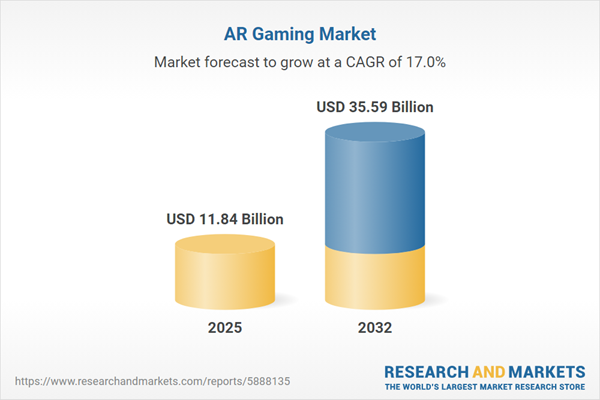Speak directly to the analyst to clarify any post sales queries you may have.
Augmented reality gaming is accelerating digital transformation for enterprises, fostering innovation, streamlining operational workflows, and enabling new revenue sources. Through targeted adoption, senior decision-makers can leverage AR gaming to achieve operational efficiency and position their organizations for long-term market leadership.
Market Snapshot: AR Gaming Market Size and Growth Trajectory
The global augmented reality gaming market reached USD 10.13 billion in 2024 and is projected to grow to USD 11.84 billion in 2025. Looking ahead, expectations point to a substantial increase to USD 35.59 billion by 2032, representing a compound annual growth rate (CAGR) of 17%. This upward trajectory results from widespread demand for immersive digital experiences and the drive to deliver differentiated solutions. Organizations remain focused on development platforms, content innovation, and adaptable engagement models to address evolving user expectations and capitalize on emerging business opportunities in AR gaming.
Scope & Segmentation: AR Gaming Sector Analysis
- AR Hardware and Services: Incorporates head-mounted displays, smartphones, tablets, smart glasses, dedicated gaming devices, and specialized software deployed in both commercial and consumer settings.
- Device Category: Integrates dedicated AR hardware and mainstream mobile devices facilitating spatial computing, aligning with both enterprise workflows and entertainment environments.
- Usage Settings: Encompasses indoor and outdoor applications enabled by GPS, beacon, and Wi-Fi technologies, supporting use cases across retail, training, entertainment, and field operations.
- Revenue Strategies: Covers in-game advertising, sponsored placements, subscription models, paid app downloads, and premium content for scalable monetization pathways.
- Primary End Users: Includes consumers, military simulation teams, healthcare trainers, education technology developers, retailers, and entertainment venues seeking enhanced digital engagement.
- Distribution Approaches: Spans digital app stores, retail channels, and operator-bundled packages to increase accessibility at both regional and global scales.
- Regional Perspectives: Assesses infrastructure capacity, adoption trends, and regulatory factors across the Americas, Europe, Asia-Pacific, and Middle East & Africa, each presenting distinct growth drivers and challenges.
- Technology Drivers: Relies on advancements in next-generation AR displays, precision sensors, energy efficiency, computer vision, 5G connectivity, and cloud computing to deliver consistent performance and reliability.
- Industry Leaders: Major contributors include Niantic, Tencent Holdings, Snap, Microsoft, Google, Apple, Unity Software, PTC, Magic Leap, and Qualcomm, each facilitating innovation and evolution within the AR gaming landscape.
Key Takeaways: Strategic Insights for AR Gaming Stakeholders
- Integrating advanced AR hardware and artificial intelligence elevates adaptive business solutions, expanding AR gaming’s impact on process improvement and operational clarity.
- Growing compatibility between platforms increases deployment flexibility, allowing organizations to tailor AR applications to diverse workflows and audience demographics.
- Partnerships among platform providers and cloud vendors expedite AR gaming deployment by reducing integration challenges, supporting business readiness.
- Use cases extend from simulation and operational efficiency to strategic customer engagement, providing practical tools for improved productivity and enhanced user experiences.
- Monetization models centered on flexible subscriptions and in-app content allow organizations to adapt quickly to changing user preferences and sustain revenue.
- Effective data privacy protocols and regulatory compliance become increasingly critical as AR gaming ecosystems expand internationally in complexity and scale.
Tariff Impact: United States Policy and Global Supply Chain Complexity
The introduction of new tariffs on electronic components in the United States has raised supply chain and manufacturing costs for augmented reality gaming products. Suppliers are evaluating alternative sourcing strategies and regionalized production models, introducing greater operational complexity and increasing the importance of meeting regulatory requirements in multiple global markets.
Methodology & Data Sources
This report is built on extensive quantitative research and informed by direct interviews with executives, developers, and end users. All insights draw on validated regulatory data, industry benchmarks, and peer-reviewed sources, ensuring actionable and reliable guidance for senior decision-makers.
Why This Report Matters: Value for Senior Decision-Makers
- Delivers segmented intelligence to inform investment priorities and streamline resource planning in the augmented reality gaming sector.
- Prepares decision-makers for regulatory and policy developments, supporting resilient growth strategies within evolving AR gaming ecosystems.
- Equips organizations with timely insights to anticipate technology trends and adjust to shifting user expectations.
Conclusion
Organizations that prioritize AR gaming solutions and strategic alliances enhance their adaptability and accelerate value creation in the digital environment.
Additional Product Information:
- Purchase of this report includes 1 year online access with quarterly updates.
- This report can be updated on request. Please contact our Customer Experience team using the Ask a Question widget on our website.
Table of Contents
3. Executive Summary
4. Market Overview
7. Cumulative Impact of Artificial Intelligence 2025
Companies Mentioned
The companies profiled in this AR Gaming market report include:- Niantic, Inc.
- Tencent Holdings Limited
- Snap Inc.
- Microsoft Corporation
- Google LLC
- Apple Inc.
- Unity Software Inc.
- PTC Inc.
- Magic Leap, Inc.
- Qualcomm Incorporated
Table Information
| Report Attribute | Details |
|---|---|
| No. of Pages | 182 |
| Published | October 2025 |
| Forecast Period | 2025 - 2032 |
| Estimated Market Value ( USD | $ 11.84 Billion |
| Forecasted Market Value ( USD | $ 35.59 Billion |
| Compound Annual Growth Rate | 17.0% |
| Regions Covered | Global |
| No. of Companies Mentioned | 11 |









